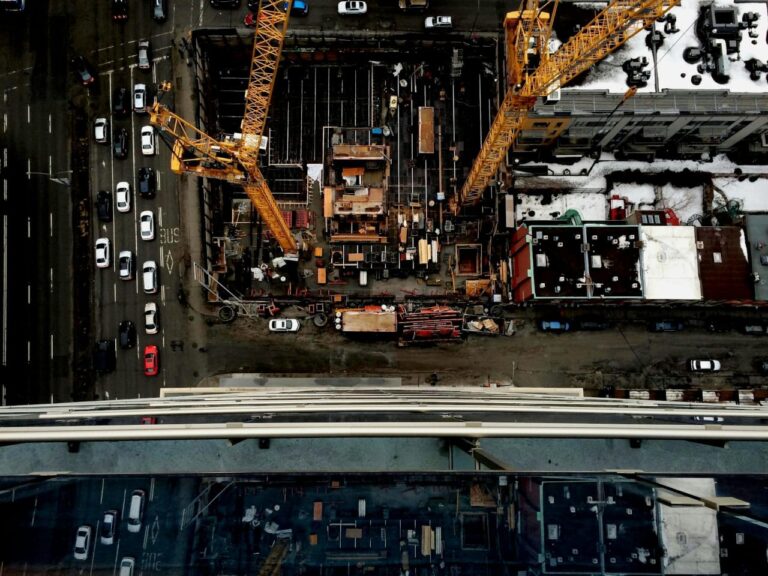Flat Roofing vs. Pitched Roofing
One of the most important decisions you have to make as a homeowner is choosing the right roofing type for your home. Roofing is the most significant part of any building and the one that is responsible for offering protection against the elements of nature. While there are several roofing options available to you, two of the most common ones are flat and pitched roofing. Flat roofs have gained popularity due to their sleek and modern design, but pitched roofs are the more conventional option. Big companies like Nitro Roofing and Construction cover installation of both flat and pitched roofs.
What is Flat Roofing?
Flat roofing systems, as the name implies, involves creating a flat surface on the roof deck with a slight slope to allow water to drain. Unlike pitched roofs that have an angle, flat roofs appear to be completely flat. It typically comprises several layers, including underlayment, insulation, a waterproof membrane, and a protective layer. Flat roofing is ideal for structures with little or no slope and where the design requires a modern and contemporary look.
Benefits of Flat Roofing
Flat roofs offer several advantages and benefits, which make them a popular option for residential and commercial building construction. One of the most significant benefits is their low cost, compared to sloped roofs due to less material and less labor intensity.
Flat roofing systems are also easy to install and maintain, which makes them convenient for property owners to manage. They are also customizable, allowing property owners to choose from different materials, colors, and thicknesses.
Drawbacks of Flat Roofing
Despite the many benefits, flat roofing has some downsides to consider when deciding whether it is the right option for you. One drawback is that flat roofs are more likely to retain debris, which can cause water pooling and damage. Heavy rainfall, snow, or hail can cause more severe problems and lead to leaks, which can be challenging and expensive to fix.
Another disadvantage of flat roofing is that it has a shorter lifespan than sloped roofs, requiring replacement more frequently. Also, some materials are vulnerable to scratches, tears, or punctures, which can increase the risk of leaks, especially for more severe weather conditions.
What Is Pitched Roofing?
A pitched roof, also known as a sloping roof or a peaked roof, is one of the most common types of roofs. The roof has two sides that slope downwards from a central ridge. The pitch, or angle of the roof, can vary from steep to shallow, depending on the architectural style of the building and the climate of the region. A steep pitch allows for better drainage and prevents snow from accumulating, while a shallow pitch is suitable for areas with mild weather.
Advantages of pitched roof
One of the advantages of a pitched roof is its excellent drainage system. The slope of the roof ensures that rainwater runs off easily and does not accumulate on the surface, which can lead to damage. The drainage system can be enhanced by installing gutters and downspouts to collect the rainwater and direct it away from the building’s foundation.
Disadvantages of Pitched Roofing
One of the main disadvantages of pitched roofing is its high cost. Pitched roofs require more materials and a longer installation process, making them more expensive than flat roof alternatives. This can be a major barrier for homeowners or businesses on a tight budget. Another drawback of pitched roofing is its susceptibility to wind damage.
The Differences between Flat And Pitched Roofing
Design
Flat roofing is known for its sleek, modern design. It uses simple geometric shapes and clean lines, and lacks the triangular form that makes pitched roofs so popular. Flat roofing has become a go-to option for minimalistic buildings due to its simple design. Pitched roofs, on the other hand, evoke a more traditional feel due to their triangular shape. If you value tradition and prefer a more classic look, pitched roofing is the way to go.
Cost
Cost is a crucial factor that many homeowners consider when deciding on roofing. Typically, flat roofs are less expensive to install than pitched roofs, and installation is typically more straightforward. However, the maintenance cost of flat roofs is usually higher, making them more expensive in the long run. Pitched roofs, despite their higher initial installation cost, require less maintenance and, therefore, are more affordable in the long run.
Weather Resistance
The weather is a significant factor that affects roofing performance. Pitched roofs are preferred due to their enhanced weather resistance capabilities compared to flat roofs. The pitch on a roof allows water to drain off quickly and efficiently, preventing water damage to the roof. In contrast, flat roofs have a shallow slope and can be prone to ponding, leading to water damage that can cause serious problems down the road.
Versatility
Flat roofs are popular due to their versatility. They can be used to create extra usable space like roof terraces, greens roofs, or solar panels for your home. With solar panels becoming more popular with homeowners, flat roofs have become a go-to for homeowners looking to install them. Pitched roofs, on the other hand, have limited functionality.
The Environment
When it comes to the environment, the roof you choose can make a difference. Flat roofs are notorious for their poor insulation capabilities compared to pitched roofs. With more insulation, you will save significant amounts of energy on heating and cooling throughout the year. The insulation in pitched roofs enables better heat retention and the external design better fits with a natural setting.
Conclusion
Choosing the right roofing material for your home can be challenging, but understanding the differences between flat and pitched roofing can make the decision simpler. Both options have pros and cons, and your decision will ultimately hinge on your needs, preferences, and overall budget.



